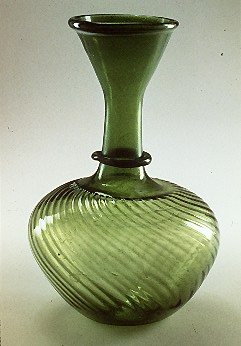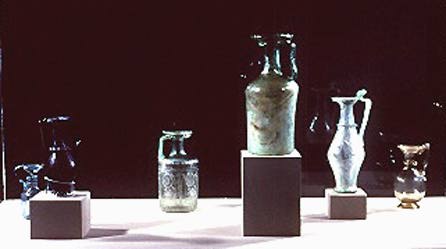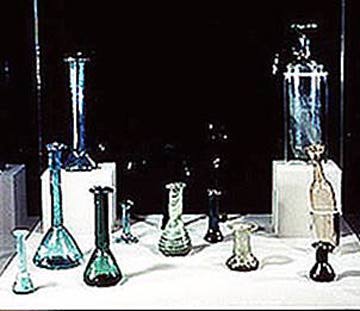

This was its origin: in a part of Syria which is called Phoenicia, there is a swamp close to Judaea, around the base of Mt. Carmel, from which the Bellus River arises . . . whose sands are purified from contamination by the torrent's flow. The story is that here a ship of natron [sodium carbonate] merchants had been shipwrecked; when they were scattered about on the shore preparing food and no stones were at hand for propping up their pots, they brought lumps of natron from the ship. The sand of the shore became mixed with the burning natron and translucent streams of a new liquid flowed forth: and this was the origin of glass.It is not surprising that the ancient authorities thought of Phoenicia as the birthplace of glass, for the Syro-Palestine region did indeed become a major center of glass production in antiquity, along with Egypt. However, glass seems actually to have been "discovered" not in Phoenicia, but in Mesopotamia. Archaeological research now places the first evidence of true glass there at around 2500 B.C. At first it was used for beads, seals, and architectural decoration. Some 1,000 years elapsed before glass vessels are known to have been produced. Vessels of glass quickly became widespread in the second half of the second millennium B.C. They were popular not only in Mesopotamia but also in Egypt and the Aegean. The earliest vessels were core-formed. Opaque, dark glass in its molten state was wound around a clay core attached to a metal rod. The skin of hot glass was fashioned with tools in order to shape its external features. Lighter colored strands of hot glass were then trailed on the surface and often "dragged" to produce festoon patterns. The pot surface was marvered (that is, rolled on a smooth, flat surface to produce a level finish). Finally, it was cooled slowly before the clay core was scraped out of the hardened vessel. This glassware typically imitated forms originally established for ceramic, metal, and stone vessels .
(Isidore of Seville, Etymologies XVI.16. Translation by Charles Witke.)
Somewhat later, the molding technique was developed, whereby glass chips or molten glass were packed or forced into a mold and then fused. After a molded vessel was annealed (cooled slowly in a special chamber of the glass furnace), it was often ground and polished in order to refine the rim and any other rough edges. One typical shape for molded vessels of the late Hellenistic and early Roman periods (c. 150 -50 B.C.) was the so-called pillar-molded bowl. Here exterior ribs radiate up from the base, stopping abruptly near the rim to allow a smooth margin around the circumference. This type is ubiquitous; and it attests to the free and rapid exchange of ideas in glass-making throughout the Greater Mediterranean sphere. Fragmentary examples in the collections of the Kelsey Museum range from Seleucia, to Karanis, to Puteoli. The site of Tel Anafa in Israel (recently excavated jointly by the Universities of Michigan and Missouri) has provided critical information on the chronological limits of these bowls within the Roman period.
Around 50 B.C. a revolutionary development occurred in the history of glass-making: the invention of free-blowing. This landmark achievement did almost certainly take place in Syro-Palestine even if the basic discovery of glass did not. Perhaps the significance attached to the Syro-Palestine glasshouses because of the discovery there of the blowing technique is at the root of the ancients' tendency to attribute to Phoenicia the invention of the actual material as well.
The free-blowing process required a continuously fired furnace. A wad of molten glass was gathered on the end of a long metal pipe. By blowing air through this pipe, the molten "gather" became a bubble of glass that could be manipulated with tools and reheated periodically for easier working. After the application of elements such as base-pedestals, a metal rod ("pontil rod") was thrust onto the bottom of the vessel and the top was cracked off the blow-pipe. Then, with further reheating, the top of the vessel received its final shaping; and elements such as handles and decorative trails were applied from a molten gather. Vessels produced in this way often preserve a scar, or "pontil mark," on the base from the removal of the pontil rod. When complete, the vessel was placed in the annealing chamber of the furnace.
With the development of free-blowing, the rather staid uniformity and refinement of cast vessels often gave way to directives of speed, spontaneity, and formal ingenuity. Less architectural in profile, blown vessels of antiquity often achieved a graceful, thin-walled elegance or a loose, plastically volumetric vigor. Depending upon the quality of the raw glass, the finished product might yield a bubbled, grainy texture or a compact and pure one. The iridescence seen on much ancient glass was not a deliberate effect created by the glass-maker. It was caused by devitrification (chemical decomposition) due primarily to prolonged contact of the objects with moist and acidic soil in their archaeological contexts. Paradoxically, vessels displaying this opaline quality are coveted by many collectors of antiquities because of their aesthetic appeal; and the effect is frequently imitated by modern glass-artists. Since the majority of glass and artifacts in the collections of the Kelsey Museum come from Egypt, with its dry climate, relatively few of them illustrate this phenomenon. They appear for the most part as they were intended to look some 1500 years ago.

Flask
Green glass with neck coil and s-corrugations on body
H. 21.5 cm
Third or fourth century AD
UM excavations at Karanis
KM 5944

It is telling that the earliest known ancient representation of glass-blowing has been found not on an object from Phoenicia, but on an object from Split, Yugoslavia: a decorated clay lamp datable to the first century B.C.; and, while Syro-Palestine and Egypt maintained their traditional importance as glass-making centers, glasshouses were already in operation in Cologne, Germany (to offer one example) by the middle of the first century B.C. Cologne rapidly developed a major industry which was continuously responsive to trends set further east, while also responsive to local predilections. Until well into the fifth centry A.D., when effects of the political dissolution of Empire began to be reflected perceptibly on the level of material culture, there was a remarkable unity in glass-making across the entire extent of Rome's purview. Not only did glass products travel (both as objects of intrinsic trade value and as receptacles for liquid commodities, but so also did glass-makers. This is clear from a variety of textual, epigraphical, and artifactual evidence.
Within a few hundred years from the invention of free-blowing, glass-blowers had developed almost all the major decorative techniques which are used by glass artists even to the present day. Thus, in essence, the glass of the Roman Empire provides a telescoped view of the techniques of art in glass generally, from antiquity until the emergence of the studio movement in our own era. The one major exception was the concept of stained glass windows, not envisioned until the Middle Ages.